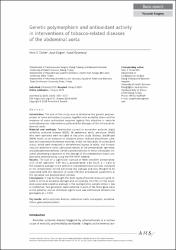| dc.contributor.author | Türker, Fevzi Sarper | |
| dc.contributor.author | Doğan, Ayşe | |
| dc.contributor.author | Özşensoy, Yusuf | |
| dc.date.accessioned | 2023-06-19T05:55:40Z | |
| dc.date.available | 2023-06-19T05:55:40Z | |
| dc.date.issued | 01.07.2022 | tr |
| dc.identifier.citation | Fevzi S. Türker Department of Cardiovascular Surgery, Elazığ Training and Research Hospital,
University of Health Sciences, Elazığ, Turkey
Ayşe Doğan Department of Physiotherapy and Rehabilitation, Health High School, Bitlis Eren
University, Bitlis, Turkey
Yusuf Özşensoy Department of Veterinary Biometrics and Genetics, Faculty of Veterinary Medicine,
Sivas Cumhuriyet University, Sivas, Turkey | tr |
| dc.identifier.uri | https://www.archivesofmedicalscience.com/pdf-108966-77042?filename=Genetic%20polymorphism%20and.pdf | |
| dc.identifier.uri | https://hdl.handle.net/20.500.12418/13699 | |
| dc.description.abstract | Introduction: The aim of this study was to determine the genetic polymorphisms
of some antioxidant enzymes together with oxidative stress and the
response of some antioxidant enzymes against this situation in vascular
and endovascular interventions performed for diseases of the infrarenal abdominal
aorta.
Material and methods: Twenty-four current or ex-smoker patients (eight
aortoiliac occlusive disease (AOD), 16 abdominal aortic aneurysm (AAA))
who were operated were included in this pilot study. Malonyl dialdehyde
(MDA) levels, as an indicator of oxidative stress, reduced glutathione, catalase
and superoxide dismutase enzymes, which are indicators of antioxidant
status, which were measured in aortofemoral bypass in AODs, and in endovascular
abdominal aortic aneurysms repairs in the preoperative, operative,
and postoperative periods. Genetic polymorphisms of these antioxidant enzymes
developing a response to the damage in the preoperative blood samples
were determined by using the PCR-RFLP method.
Results: The lack of a significant increase of MDA (nmol/ml preoperative:
2.57 ±0.19, operative: 2.59 ±0.21, postoperative: 2.64 ±0.22, p = 0.63) in
the oxidative damage in the operative and postoperative periods compared
to the preoperative period prevented the damage and was thought to be
associated with the elevation of some effective antioxidant parameters in
the operative and postoperative periods.
Conclusions: It may be thought that both types of interventions are quite reliable
in terms of oxidative damage and, accordingly, the effect of the procedure-
associated oxidative damage in the postoperative complications is low
or ineffective. Two genotypes were obtained in each of the three gene areas
of the patients, and no statistical significance was determined between the
genotypes (p > 0.05). | tr |
| dc.language.iso | eng | tr |
| dc.publisher | TerMedia | tr |
| dc.relation.isversionof | 10.5114/aoms.2019.86760 | tr |
| dc.rights | info:eu-repo/semantics/openAccess | tr |
| dc.subject | aorta occlusive disease, abdominal aortic aneurysms, oxidative stress, gene polymorphism. | tr |
| dc.title | Genetic polymorphism and antioxidant activity in interventions of tobacco-related diseases of the abdominal aorta | tr |
| dc.type | article | tr |
| dc.relation.journal | Archives of Medical Science | tr |
| dc.contributor.department | Veteriner Fakültesi | tr |
| dc.identifier.volume | 18 | tr |
| dc.identifier.issue | 4 | tr |
| dc.identifier.endpage | 1077 | tr |
| dc.identifier.startpage | 1071 | tr |
| dc.relation.publicationcategory | Uluslararası Hakemli Dergide Makale - Başka Kurum Yazarı | tr |















